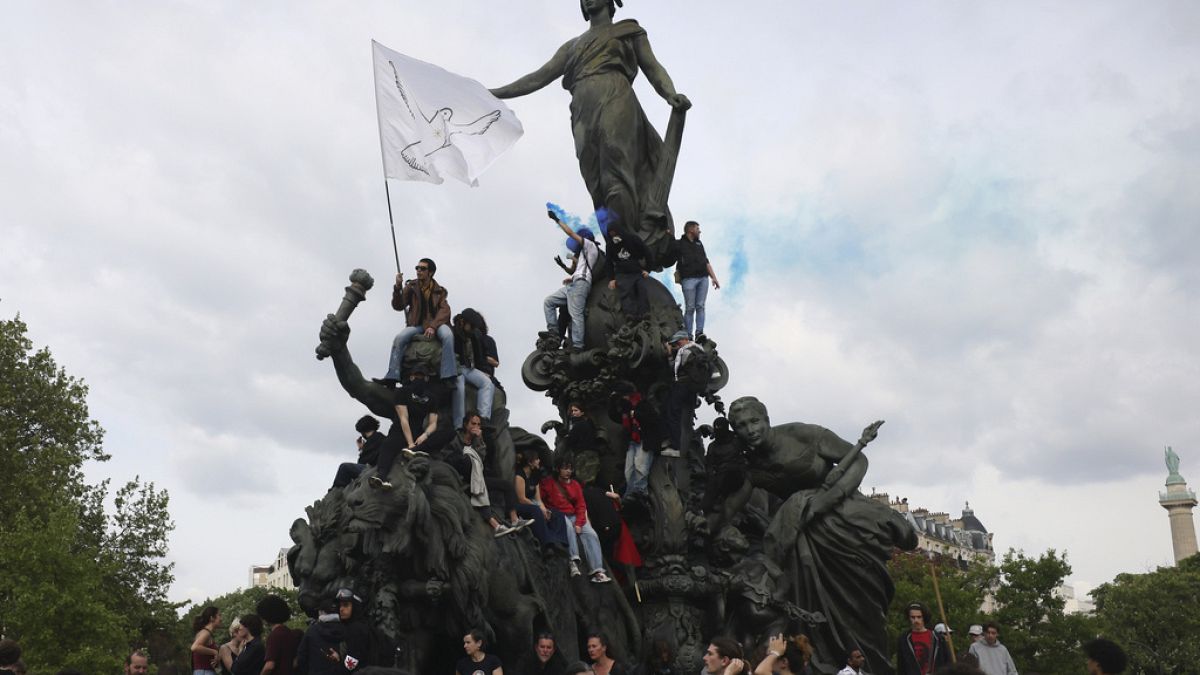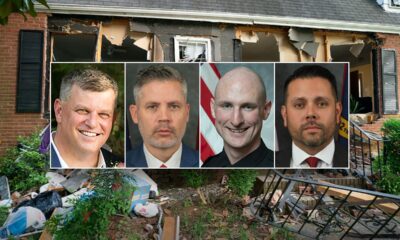Politics
Ukrainians contemplate the once unthinkable: Losing the war with Russia

Could Ukraine lose this war?
For more than two years, as this country of 44 million people has fought off an all-out invasion by neighboring Russia, a spirit of stubborn optimism prevailed even amid the most frightening moments. Any notion of defeat was unthinkable, an almost taboo topic.
But now the question hovers, flitting in and out of view: What if?
The stalling of crucial American aid, a distinct dimming of the world spotlight, and simple war weariness are all exacting a heavy cost. On the front lines, exhausted Ukrainian troops are rationing ammunition as they fend off the latest Russian advances, and anxiety is mounting along with the military and civilian toll.
“Every day, we’re dying,” said Marta Tomakhiv, 33, standing in a sharp-edged shadow in Kyiv’s main Independence Square, mourning a friend from her western Ukrainian hometown who was killed in battle days earlier in the east.
A Ukrainian serviceman with howitzer weaponry in the Donetsk region of eastern Ukraine on April 11, 2024.
(Alex Babenko / Associated Press)
By and large, Ukrainians still believe they can hold out against a resurgent and powerful foe — if for no other reason, as nearly everyone here points out, than that they are in a fight for their lives.
“There’s absolutely no choice — we know very well what they would do to us if they could,” Artem Morhun, a 30-year-old lawyer on his way to work in downtown Kyiv, said of the invading Russian forces.
Few Ukrainians have forgotten the brutal atrocities carried out by occupying Russian troops in Kyiv’s once-placid suburbs early in the war, or the wholesale destruction and mass death in still-captive cities such as Mariupol, in the country’s southeast.
After months of military setbacks, however, many here wonder whether the long front lines that arc across Ukraine’s south and east can hold, or even whether Russian troops could seize a major city.
Without a rapid infusion of aid, “it will be much harder for us to fight,” said Andriy Borovyk, 38, who was having a coffee outdoors with a friend in the city center. “I think we could lose some territories, definitely.”
Like many others here, he likened the attitude of some of Ukraine’s allies to that of European leaders before World War II, as Adolf Hitler was coming to power.
“I think that Westerners are in a warm bath, as we say in Ukraine — like in 1939, they think it will never affect them,” said Borovyk, who works for an anti-corruption nongovernmental organization. “But it will. History has a cycle.”
A metropolis the size of Chicago, Kyiv bears the earmarks of any sophisticated European capital: stately architecture, craft breweries, ubiquitous electric scooters, colorful springtime blooms in spacious, well-tended parks. But beneath the bustle runs an undercurrent of dread.
Although Kyiv lies hundreds of miles from the battle zone, war’s hallmarks are in plain view: a sea of fluttering blue-and-yellow flags commemorating fallen soldiers, QR codes plastered on posters for crowdfunding efforts to buy drones or other supplies for field units, men and women in camouflage uniforms kissing loved ones goodbye at train stations.
Even an open-air display of wrecked, rusting Russian military vehicles — installed early in the war as a morale booster in a square outside a landmark Kyiv monastery — is more likely these days to inspire a frisson of foreboding than a spurt of national pride.

People view captured Russian equipment, including tanks, in front of St. Michael’s monastery in Kyiv, Ukraine.
(Pete Kiehart / For The Times)
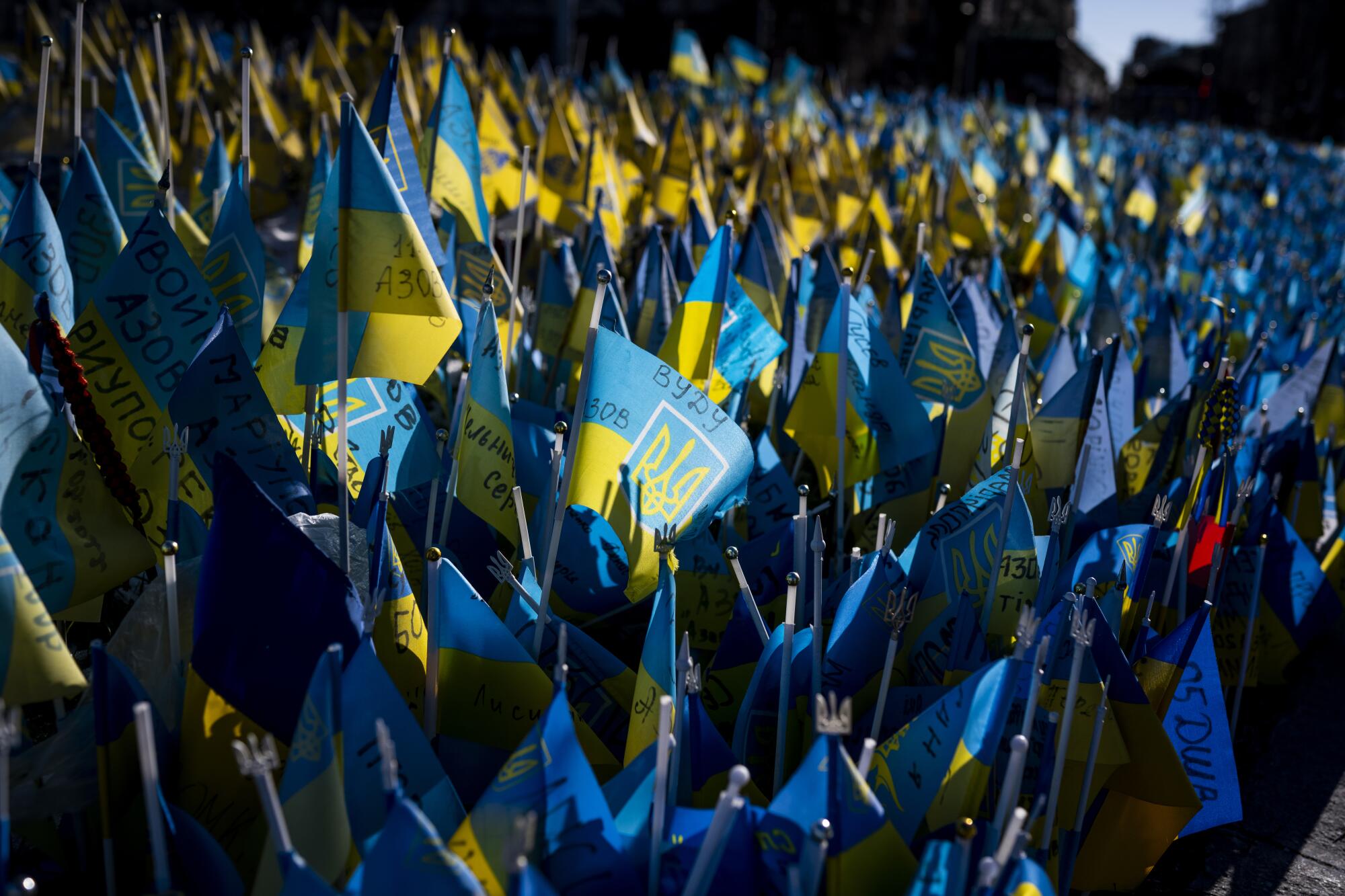
A sea of flags, each representing a fallen Ukrainian soldier, is displayed on Independence Square in Kyiv.
(Pete Kiehart / For The Times)
In the war’s heady early months, after Russian forces menaced Kyiv but then were forced to pull back, people flocked to the square to take selfies, and children played tag between the hulking wrecks. The display has been a frequent backdrop for visiting foreign dignitaries, including President Biden, who strolled the square last year.
For Marina Kozulina, a 50-something Kyiv woman walking her little black dog near a half-ruined tank, the military detritus in the square has become more a reminder of peril than triumph.
“Seeing this makes me nervous, to think about how close the Russians were to Kyiv, and if they could be again,” she said. “I want us to win, but it’s very difficult.”
Even President Volodymyr Zelensky, the former comedian who has tirelessly rallied compatriots since the invasion of Feb. 24, 2022, is taking an increasingly grim tone as cities across the country are pummeled nightly by relentless Russian drone and missile attacks.
“It is quite obvious that our existing air defense capabilities in Ukraine are not sufficient,” he said in a recent nightly address. “And it is obvious to our partners.”

Ukrainian President Volodymyr Zelensky inspects the fortification lines in the Kharkiv region on April 9, 2024.
(Ukrainian Presidential Press Office )
More gloomy news from the battle zone came Saturday, as the head of Ukraine’s military warned that conditions in the country’s east had “significantly worsened” in recent days.
Writing on the messaging app Telegram, the military chief, Gen. Oleksandr Syrskyi, said warmer spring temperatures were drying up previously muddy terrain, allowing Russian forces to step up their assaults with tanks and other armored vehicles.
Until recently, explicit talk of potential military defeat was considered largely out of bounds for Ukrainian officials, because they did not want to appear to be seeking expensive Western backing to wage what could ultimately prove a fruitless struggle.
But Zelensky did not mince words in a video meeting last weekend with a Ukrainian aid group: “It is necessary to specifically tell Congress that if Congress does not help Ukraine, Ukraine will lose the war,” he said.
Many Ukrainians have an extremely detailed grasp of U.S. election-year politics, and any visiting American is asked again and again: When is more help coming?
“We’re grateful — more than grateful,” said Anastasia Shevchuk, 16, who was out shopping downtown with friends. “But everyone understands that if Russia wins here, it’s a big, big threat to all of Europe, and the rest of the world as well.”
Attention here is heavily focused on the $60-billion U.S. aid package that has been blocked for months by congressional Republicans. It may yet be put to a vote this month, but is still in danger of being derailed by internecine fighting in the GOP.
“Voting on this aid, it’s a matter of life and death — we depend on our partners, especially the U.S.,” said Bohdan Krylyvenko, 38, sitting in the sunshine outside a fast-food restaurant. “You might think, ‘Oh, McDonald’s is open, everything looks OK. But it’s totally not OK.”
Across the country, near-nightly Russian attacks exact a growing toll. The United Nations’ human rights monitoring mission in Ukraine said this week that at least 604 Ukrainian civilians were killed or injured in such strikes — hitting apartment blocks and shops, churches and cultural sites — in March.
“The situation in Ukraine is dire; there is not a moment to lose,” the U.S. ambassador to Ukraine, Bridget Brink, wrote Thursday on the social media platform X. She noted the latest predawn air alert at 4:15 a.m., as missile barrages struck several parts of the country.
In a conflict marked by dramatic ups and downs over the last two years — initial fears that Ukraine would be swiftly subdued, an inspirational underdog narrative as the country successfully defended itself, stunning Ukrainian counteroffensives in the country’s south and east in 2022 — recent months, by contrast, have brought a drumbeat of bad news.
Last year’s much-vaunted summer counteroffensive foundered amid muted but pointed mutual recrimination between Ukrainian officials and American backers over battle tactics. The eastern town of Avdiivka fell to Russian forces in February, the first such Ukrainian loss in nine months, a defeat perhaps even more stinging symbolically than tactically.
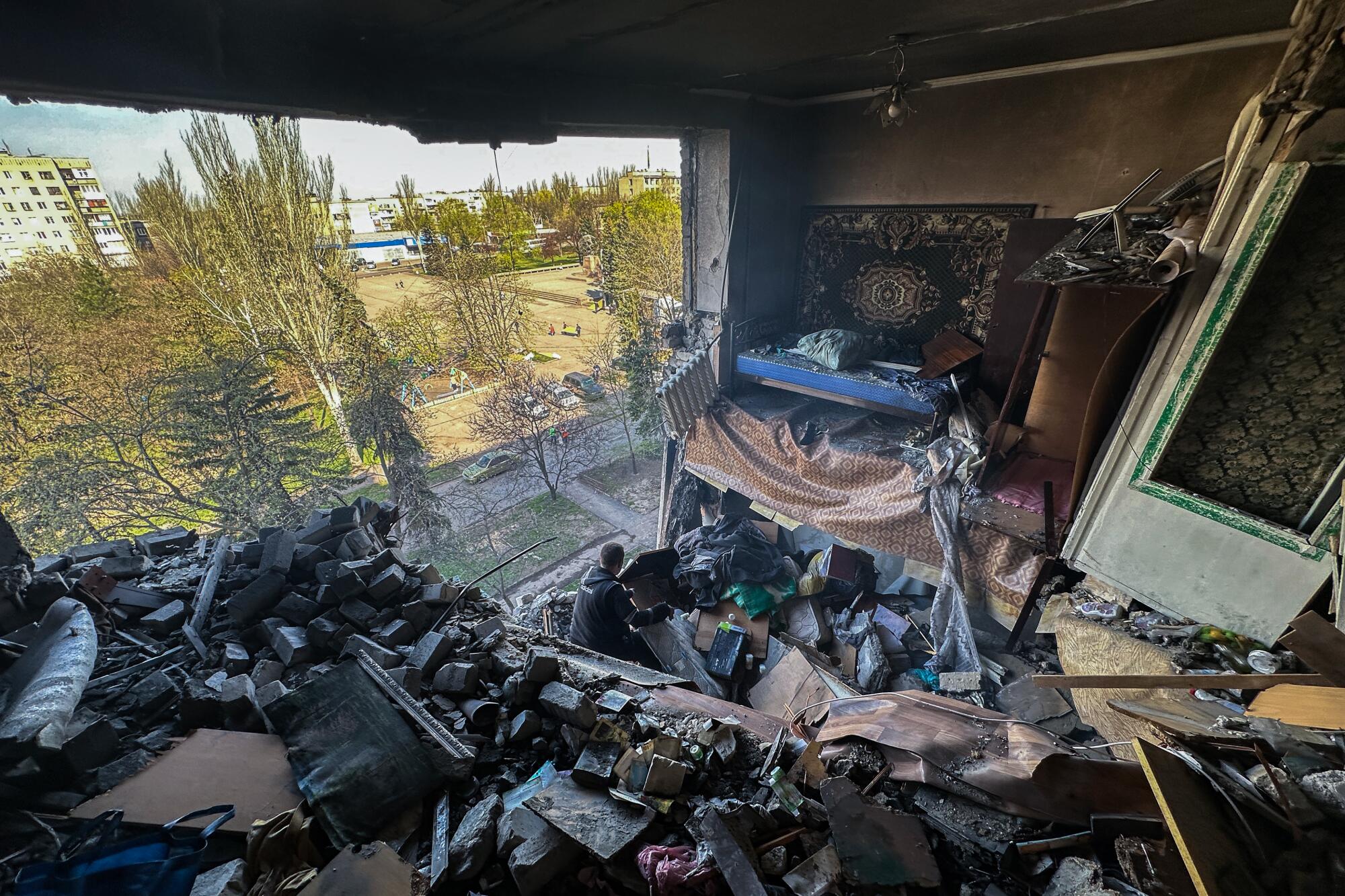
An apartment in a nine-story building damaged by Russian shelling on April 9, 2024, in Selydove, in eastern Ukraine.
(Oleksandr Buriak / Getty Images)
Manpower shortages in the ranks of a professional army bolstered at the war’s outbreak by citizen soldiers — teachers, accountants and mechanics who rushed to volunteer — have forced an unpopular measure to lower the military mobilization age from 27 to 25. And in the battle zone, artillery stocks have dwindled alarmingly, the senior U.S. commander in Europe warned Congress on Wednesday.
Testifying before the House Armed Services Committee, Army Gen. Christopher Cavoli said that within weeks, Ukrainian forces will be vastly outgunned if more armaments are not rushed in.
“They are now being outshot by the Russian side 5-1,” Cavoli said of Ukrainian troops. “The Russians fire five times as many artillery shells at the Ukrainians than the Ukrainians are able to fire back. That will immediately go to 10-1 in a matter of weeks.”
The general added: “We’re not talking about months. We’re not talking hypothetically.”
The Ukrainian side can claim successes as well, some of which its leaders believe have gone unfairly unheralded. Those include stepped-up domestic production of much-needed drones, and securing a shipping lane for grain exports as Ukraine — a country without a formal navy — has sunk or disabled one-third of all Russian warships in the Black Sea with missile and drone attacks.
Ukraine has also harried Moscow with strikes aimed mainly at Russian energy installations — mirroring, though at a far smaller scale, the destructive Russian attacks aimed at Ukraine’s power grid. But some Ukrainian officials have grumbled that they are not allowed to use Western-supplied weaponry beyond the country’s borders.
Military analysts say the drop-off in aid not only contributes to battlefield hardship now, but also makes it difficult for Ukraine to make plans to try to recapture military momentum.
“It’s a dual challenge — to stabilize the current front line, and put in place significant defenses so the Russian advances this year are blunted,” said Matthew Savill, the director of military sciences at the Royal United Services Institute, a British defense and security think tank.
Because of the immediate and short-term difficulties, a major Ukrainian counteroffensive this year is a near-impossibility, he said.
In the meantime, European allies are seeking to break the U.S. congressional logjam. On Tuesday, British Foreign Secretary David Cameron met with Secretary of State Antony J. Blinken, describing the blocked assistance as not only pivotal for Ukraine, but also “profoundly in your interest” — that of the United States.
In a telling bit of realpolitik, however, the British foreign secretary also made the trek to Florida for a meeting with former President Trump, who, as he seeks a second term, has played a key role in dissuading his congressional allies from endorsing the aid. After the meeting, Cameron made no claim of progress.
In every corner of Ukraine, the fallen return home daily.
In Kyiv this week, two wooden caskets bearing soldiers’ bodies were brought to Independence Square — the heart of Ukraine’s 2014 pro-democracy protests — in a solemn parade, with mourners kneeling at their passing.

People pay their respects to two Ukrainian servicemen killed in a battle with Russian troops during the funeral ceremony in Independence Square in Kyiv on April 9, 2024.
(Efrem Lukatsky / Associated Press)
Looking on was a 36-year-old lieutenant colonel named Bohdan, a friend of one of the dead soldiers. He described his feelings when his own 2-year-old son, no stranger to air alerts, asked him when the missiles would come again.
“When he grows up, I don’t want him to have to fight this kind of war, but without the world’s help, maybe he will have to,” said the officer, who, in keeping with military policy, did not want his full name used.
He watched bleakly as the coffins were carried to the foot of a towering monument to Ukraine’s 1991 independence.
“Many people, the best people of our nation, will die,” he continued. “But we will fight. We have no choice.”

Politics
Adams, NYPD cite 'global' effort to 'radicalize young people' after 300 arrested at Columbia, CUNY

New York City Mayor Eric Adams and New York Police Department (NYPD) leadership cited a “global” movement to “radicalize young people” in announcing approximately 300 arrests at Columbia University and City College that took place overnight.
“I know that there are those who are attempting to say, well, the majority of people may have been students. You don’t have to be the majority to influence and co-opt an operation. That is what this is about. And so, if we want to play the word police, you could do so. I’m going to play the New York City police,” Adams said at a press conference. “There is a movement to radicalize young people, and I’m not going to wait until it’s done and all of a sudden acknowledge the existence of it. This is a global problem that young people are being influenced by those who are professionals at radicalizing our children. And I’m not going to allow that to happen as the mayor of the city of New York.”
Adams made clear that making arrests at schools and removing those who did not belong on campus is far from the end of the problem.
“We know that this is only a comma in the full sentence of public protection in this city. This is not a celebratory, a moment,” Adams said. “We can’t create environments while children could be in danger, and we must push back on all attempts to radicalize our young people in this city like we’re seeing across the entire globe.”
TWO COLUMBIA STUDENTS WHO FACED OFF WITH MOB SPEAK OUT, CLAIM A CAR FULL OF ‘MASKED PEOPLE’ SURVEILLED THEM
NYPD Commissioner Edward Caban, right, and Mayor Eric Adams appear at a press conference as Caban holds up chains and a lock removed by officers during their operation to clear protestors from Columbia University on May 1, 2024. (REUTERS/Mike Segar)
The day after Columbia University President Minouche Shafik was hauled before the House Education and the Workforce Committee in Washington, D.C., about growing antisemitism at the Ivy League school, Columbia leadership allowed police onto their private campus on April 18 to arrest over 100 people. However, as protesters reorganized and an anti-Israel encampment – involving even some professors who Shafik testified before Congress had been fired or reprimanded over antisemitic remarks praising Hamas’ Oct. 7 slaughter of about 1,200 Jews – persisted for about two weeks, the university president opted to keep police out.
Shafik instead had administrators attempting negotiations with protest organizers demanding the university “divest” from Israel. That was until demonstrators took over Hamilton Hall.
Approximately 300 people were arrested at Columbia and nearby City College overnight. Preliminary charges range from trespass to criminal mischief to burglary, police said.
In an apparent reference to Columbia University locking its gates to keep police out on the sidewalk, NYPD Commissioner Edward Caban held up chains at Wednesday’s press conference.
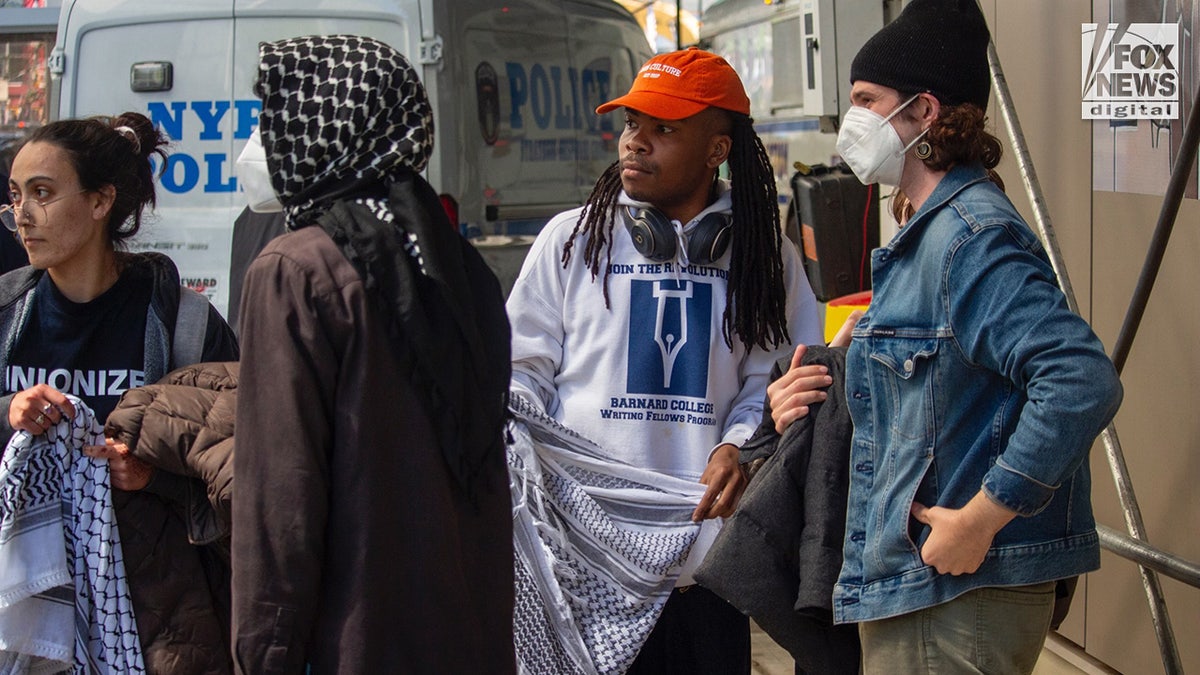
Anti-Israel agitators block bystanders’ views as protesters are placed in the back of a police vehicle in New York City on Wednesday, May 1, 2024. Roughly 300 protesters were arrested at Columbia University and City College overnight. (John M. Mantel for Fox News Digital)
“They tried to lock us out. But the NYPD and the people of the city of New York will never be locked out. And we will always work together to keep our city safe,” he said, slamming down the chains afterward.
Over the past week, Columbia leadership acknowledged in discussions with NYPD officials that “outside agitators were on their grounds training and really co-opting this movement,” Adams said, and, “at the request of Columbia University,” police conducted an operation to “to remove those who have turned the peaceful protest into a place where antisemitism and anti-Israel attitudes were pervasive.”
The mayor told reporters that those who broke into Hamilton Hall were “led by individuals who are not affiliated with the university,” and Columbia needed the assistance of the NYPD to clear the building and the encampment outside through a “dual operation.”
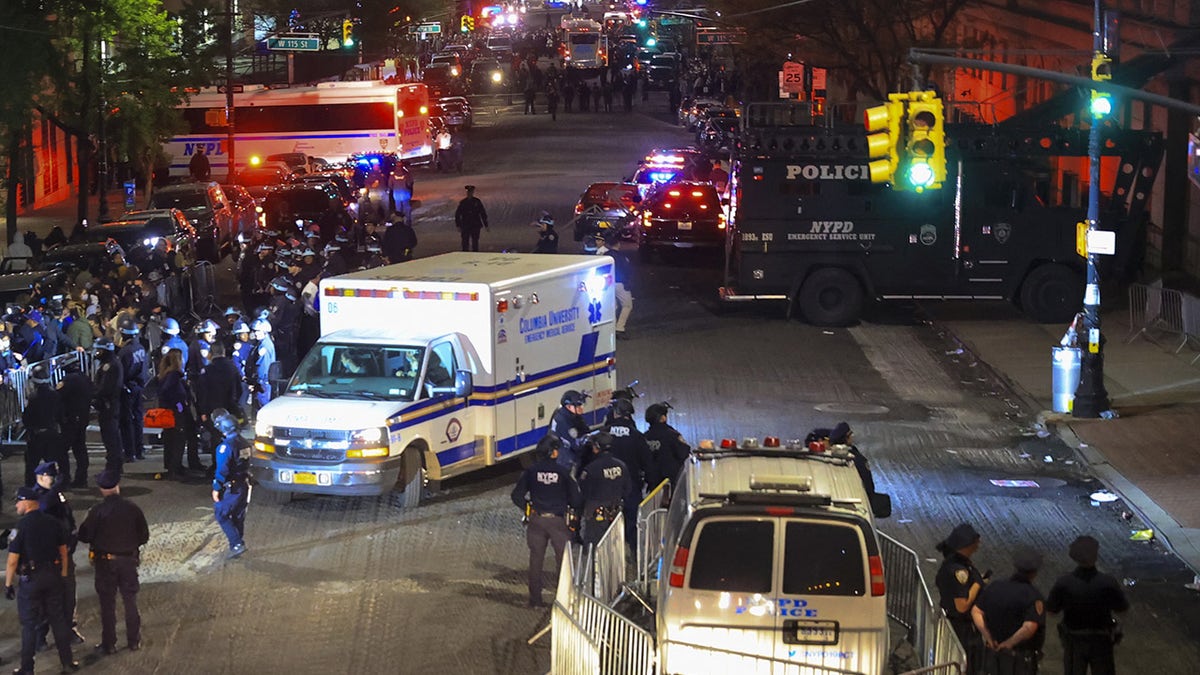
NYPD officers detain dozens of anti-Israel protesters at Columbia University after they barricaded themselves at the Hamilton Hall building near Gaza Solidarity Encampment earlier on April 30, 2024. (Selcuk Acar/Anadolu via Getty Images)
Recognizing “similar indicators” from the Black Lives Matter demonstrations of 2020, the mayor said campus protests involved “external actors with a history of escalating situations and trying to create chaos.”
“Students have a right to protest, and free speech is the cornerstone of our society,” Adams said. “But as our major concern, we knew, and we saw that there were those who were never concerned about free speech. They were concerned about chaos. It was about external actors hijacking a peaceful protest and influence students to escalate. There’s nothing peaceful about barricading, building, destroying property or dismantling security cameras.”
Since the Oct. 7 terrorist attacks, the NYPD has responded to more than 2,400 protests, about 1,000 of which focused on the situation with Israel and Palestinians, Caban added.
ANTI-ISRAEL MOB AT COLUMBIA REVEALS EXACTLY WHAT THEY WILL TARGET NEXT AFTER TAKING OVER ACADEMIC BUILDING
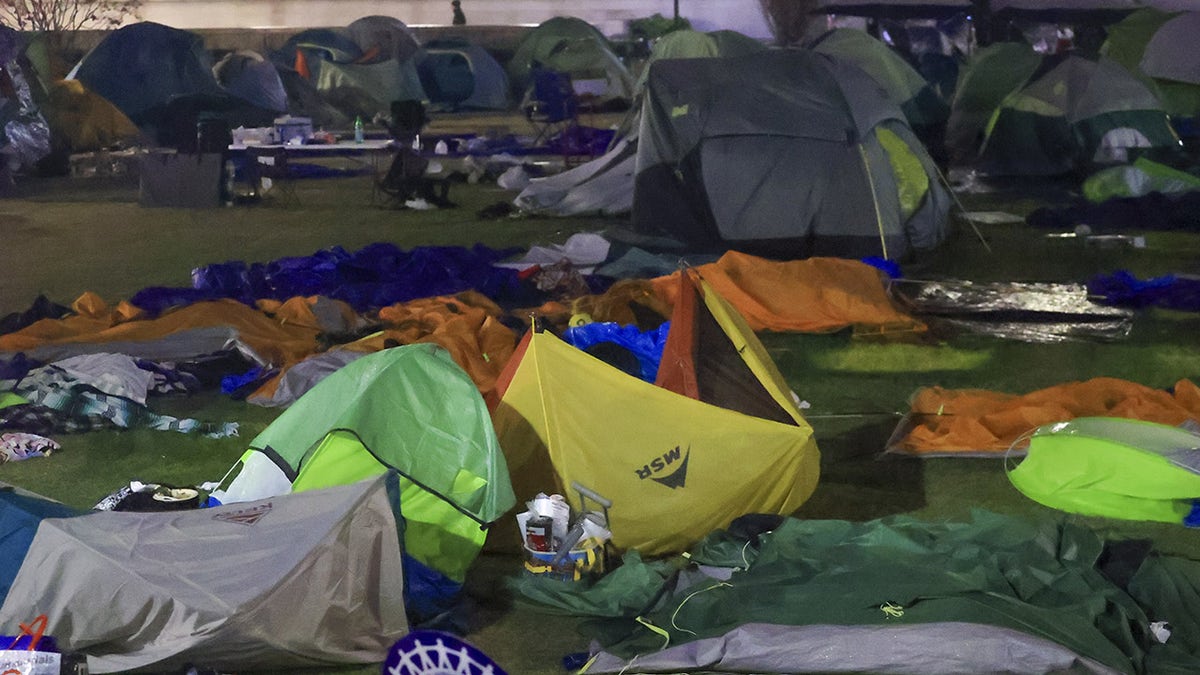
Police dismantled an anti-Israel encampment at Columbia University after protesters barricaded themselves at Hamilton Hall on April 30, 2024. (Selcuk Acar/Anadolu via Getty Images)
NYPD Assistant Commissioner Rebecca Weiner cited how a number of individuals who law enforcement know from over the years as being associated with protests in New York City and elsewhere in other cities have been “doing training around the change in tactics.” Pointing to the campus organization effort, she referenced how demonstrators wore “Black bloc attire,” broke windows, engaged in vandalism and property destruction, barricaded themselves and how “makeshift weapons” were recovered from the encampment. Tactics used by anti-Israel agitators also included “fomenting chaos” and “squatting.”
“That change in tactics combined with the presence of known individuals on campus in the lead up to what happened in Hamilton Hall is why we had a real elevated concern around public safety,” she said, turning to why officers needed protective gear. “When you’re going into a situation that you don’t fully understand what might greet you on the other side of the door. So this is important, and it is not just a New York City issue. It’s obviously not just a Columbia issue. We saw it spread to CCNY last night, but this is unfolding across the country and in Europe as well. So this is a challenge we’re all going to be dealing with for some time.”
Adams said the NYPD “cannot get caught up on what’s the political correct terminology” and instead must focus on public safety and removing “individuals on campus who should not have been there.”

The NYPD at the Hamilton Hall building at Columbia University on April 30, 2024. (Selcuk Acar/Anadolu via Getty Images)
“We saw evidence of training. We saw a shift in tactics that were being used,” Adams said. “And when you start using the intelligence that intel was able to supply, we knew it was time to communicate directly with the school and say, you have more than a peaceful protest on your hands.”
NYPD officials praised the officers’ professionalism, saying that an “overwhelming majority” of those approximately 300 arrests happened without any injuries or serious scuffles with police.
Adams also blasted how protesters took down the American flag and erected a Palestinian flag at campuses.
“That’s our flag folks. Don’t take over our buildings and put another flag up,” the mayor said. “That may be fine to other people, but it’s not to me. My uncle died defending this country and these men and women put their lives on the line and it’s despicable that schools will allow another country’s flag to fly in our country. So blame me for being proud to be an American. And I thank, Commissioner [Kaz] Daughtry, for putting that flag back up. We’re not surrendering our way of life to anyone.”
Politics
As tensions grow, more Americans see China as an enemy

Americans are increasingly concerned about China’s power abroad and want to combat that influence, according to a new poll by the Pew Research Center.
Some 42% of respondents indicated that they consider China an enemy of the United States — up from 34% in 2021 when the Washington-based research organization began asking the question.
The study, published Wednesday, also found 71% of Americans believe China’s global influence has been growing in recent years.
Nearly half of respondents said limiting China’s power should be a top priority for U.S. foreign policy, along with protecting the U.S. from terrorist attacks and curbing the flow of illegal drugs into the country.
The rising suspicion comes as the two countries clash on a growing number of issues and the major candidates in the U.S. presidential election vow to stand tough on China.
Both President Biden and presumptive Republican nominee Donald Trump have expressed concerns about the impact of low-cost Chinese goods on American industries. About two-thirds of respondents in the Pew survey believe that China has a negative impact on U.S. economic conditions.
Biden recently called for the tripling of tariffs on Chinese steel and aluminum to target what he called “unfair trade practices” by China. And on a trip to Beijing last month, Treasury Secretary Janet L. Yellen raised the issue of “overcapacity” in Chinese manufacturing of electric cars and other clean-energy goods.
Last week, U.S. Secretary of State Antony J. Blinken met with Chinese President Xi Jinping and other officials in Beijing to discuss long-simmering sources of tension. Blinken raised the need to stem the supply of fentanyl from China to the U.S. and warned China to stop providing tools and technology to Russia for use in the war in Ukraine.
“Russia would struggle to sustain its assault on Ukraine without China’s support,” Blinken said in a news conference Friday. “I made clear that if China does not address this problem, we will.”
Meanwhile, China’s top diplomat, Wang Yi, criticized the U.S. for using trade policy and sanctions to contain China’s economic development. Wang also reiterated his government’s concerns about U.S. interference in China’s claim on Taiwan and called on Biden to respect Beijing’s sovereignty over the island democracy.
The high-level meetings followed the passage of a U.S. bill that allocated $8 billion in funding for Taiwan. The bill, which Biden signed last week, would also force a ban of TikTok in the U.S. if the Chinese-owned company does not sell its short-video app business.
To assess American attitudes toward China, Pew researchers surveyed a representative sample of 3,600 U.S. adults by mail, text and email during the first week of April.
The survey found that 81% of U.S. adults view China unfavorably, a slight decline from 83% last year but still near the highest level in data going back to 2005. Public opinion has changed radically since 2017, when about 47% of respondents held unfavorable views of China and 43% held favorable ones.
Politics
Newsom, state officials silent on anti-Israel protests at UCLA

California Gov. Gavin Newsom, a Democrat, and other state officials running to replace him after his term is up have refrained from commenting on the anti-Israel protests at the University of California, Los Angeles and the University of California, Berkeley.
Newsom has not released a statement about his stance on the campus protests, as of Wednesday morning.
The governor was asked about the demonstrations during a news conference on a different topic on Tuesday, when he said he and other state officials were “working with the [UC] trustees,” according to KNBC.
“We want to maintain the right to protest without any hate,” Newsom said.
VIDEO SHOWS ANTI-ISRAEL PROTESTERS BLOCK JEWISH STUDENT FROM GETTING TO CLASS; UCLA RESPONDS
Newsom’s office has not released a statement on the campus protests. (Justin Sullivan/Getty Images)
Members of the UC Regents, including Democratic gubernatorial candidates Lt. Gov. Eleni Kounalakis and State Superintendent of Public Instruction Tony Thurmon declined to comment to KNBC. State Assembly Speaker Robert Rivas also declined to comment on the campus protests.
Republicans have openly criticized campus protests in California and across the country, condemning them as antisemitic. But Newsom and his Democratic colleagues have attempted to avoid the subject.
Violence ensued at UCLA late Tuesday night and into Wednesday morning as anti-Israel and pro-Israel demonstrators clashed. Fights broke out, items were thrown and fireworks and what appeared to be pepper spray were deployed.
Dozens of pro-Israeli counter-protestors arrived at around 10:45 p.m. and attempted to dismantle parts of the anti-Israel encampment on UCLA’s campus before deploying fireworks and what appeared to be pepper spray, according to KTLA.
Campus police, along with some medical personnel, showed up at the scene briefly before leaving. But local and state police were noticeably absent from UCLA’s campus initially, for about two hours, amid the violence.
CALIFORNIA UNIVERSITY REVEALS ‘TRUE COST’ OF ANTI-ISRAEL MOB THAT TOOK OVER ACADEMIC BUILDINGS
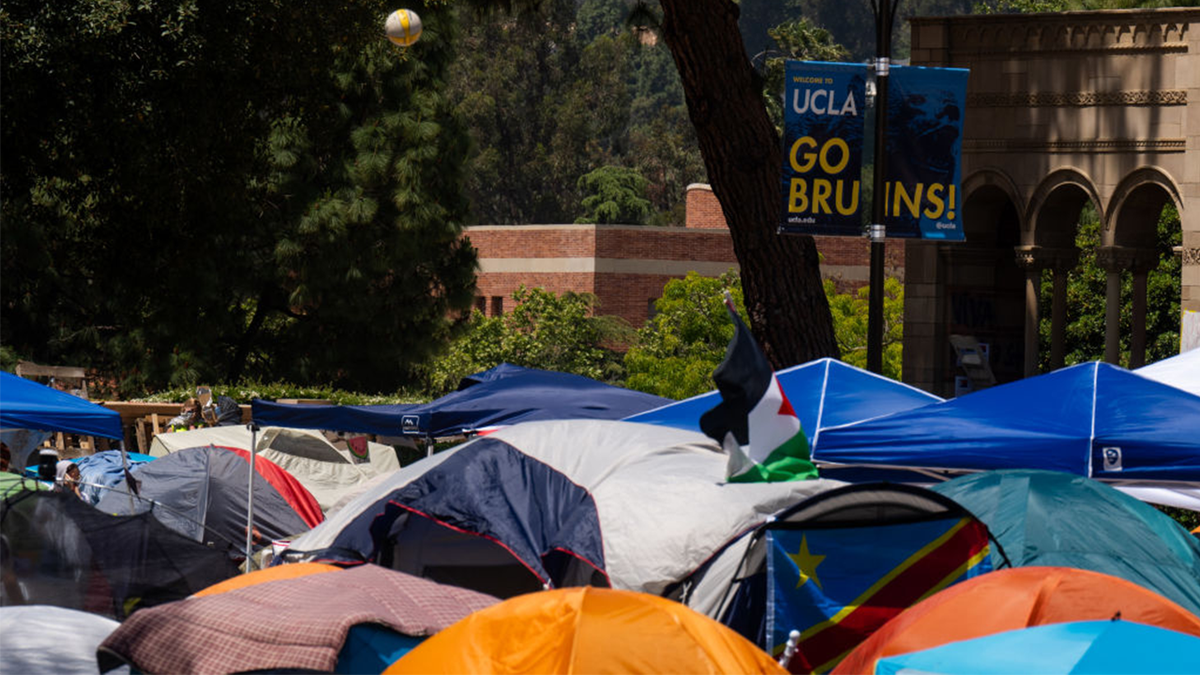
Violence ensued at UCLA late Tuesday night and into Wednesday morning as anti-Israel and pro-Israel demonstrators clashed. (Getty Images)
Los Angeles Police eventually responded to the scene at about 1 a.m. local time.
Newsom’s press office said Wednesday morning on X: “Our office is closely monitoring the situation at @UCLA. Law enforcement leaders are in contact this evening and resources are being mobilized.”
On Monday, a student wearing a necklace with the Star of David was seen on video attempting to walk to class when a wall of what appeared to be masked anti-Israel protesters blocked him from passing through.
“You guys have closed the entrance. We are UCLA students. I have my ID right here. I’m being blocked off, not by the security guard, but by you three,” Eli Tsives said in the video as he walked up to a fenced area with a security guard present. “They’re making a barrier wall. I’m going this way.”
UCLA Vice Chancellor of Strategic Communications Mary Osako issued a statement Tuesday in response to several physical altercations on the campus. She said the university took several actions in response to the altercations, including the addition of more campus law enforcement, safety personnel and student affairs monitors.
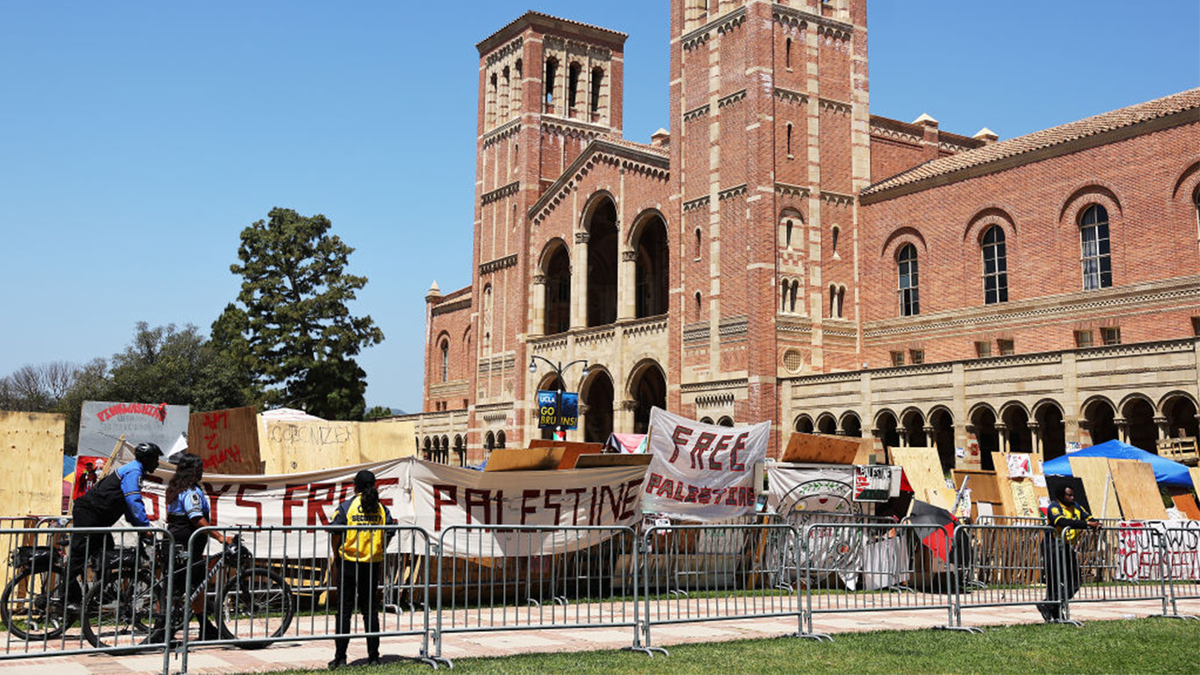
Republicans have openly criticized campus protests in California and across the country. (Getty Images)
Osako also responded to a report of a student being blocked by demonstrators on Monday while attempting to walk to class.
“This kind of disruption to our teaching and learning mission is abhorrent, plain and simple,” Osako said. “As such, we’ve taken several, immediate actions: Our student conduct process has been initiated and could lead to severe disciplinary action including expulsion or suspension. The barriers that demonstrators used to block this student’s access to class have been removed, and we have staff located around Royce Quad to help ensure that they will not go up again. We have also engaged law enforcement to investigate.”
“While the demonstration remains largely peaceful, our campus must remain a place where we treat one another with respect and recognize our shared humanity — not a place where we devolve into violence and bullying,” she added.
-

 Education1 week ago
Education1 week agoVideo: Dozens of Yale Students Arrested as Campus Protests Spread
-

 World6 days ago
World6 days agoHaiti Prime Minister Ariel Henry resigns, transitional council takes power
-

 News7 days ago
News7 days agoLarry Webb’s deathbed confession solves 2000 cold case murder of Susan and Natasha Carter, 10, whose remains were found hours after he died
-

 Politics1 week ago
Politics1 week agoFetterman hammers 'a–hole' anti-Israel protesters, slams own party for response to Iranian attack: 'Crazy'
-

 World1 week ago
World1 week agoPeriod poverty still a problem within the EU despite tax breaks
-

 World7 days ago
World7 days agoUS secretly sent long-range ATACMS weapons to Ukraine
-

 News6 days ago
News6 days agoFirst cargo ship passes through new channel since Baltimore bridge collapse
-

 World1 week ago
World1 week agoTurkey’s Erdogan meets Iraq PM for talks on water, security and trade
